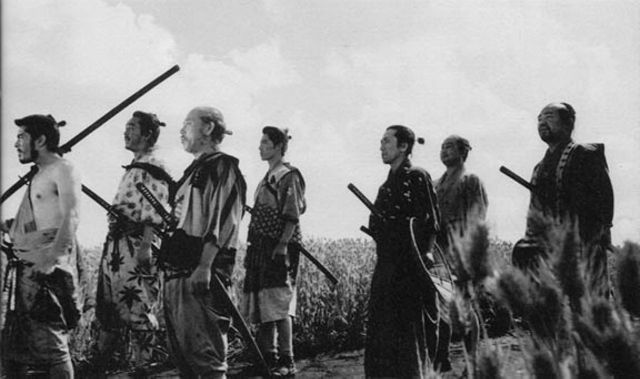Seven Samurai (1954) 
“The Mighty Warriors Who Became the Seven National Heroes of a Small Town”

Director: Akira Kurosawa
Cast: Toshirô Mifune, Takashi Shimura, Keiko Tsushima
Synopsis: A poor village under attack by bandits recruits seven unemployed samurai to help them defend themselves.
Seven Samurai, one of Akira Kurosawa’s most famous works thanks largely to its 1960 Hollywood remake, The Magnificent Seven, is something of a milestone movie in as much as it established a formula that is now commonplace in the action genre: the assembling of a group of men to fight some seemingly insurmountable foe. In fact, it pretty much transformed the genre, providing the template from which films like The Dirty Dozen and The Guns of Navarone were drawn. It also provides an intelligent insight into the conflicts and prejudices created by the rigid Japanese caste culture which the film’s key characters must overcome if they are to succeed in their mission. Not only was Seven Samurai Kurosawa’s call for social unity and harmony, it was also an apology for the less savoury exploits of the Samurai caste from which he was descended.
The film opens with a peasant villager overhearing the leader of a gang of marauding bandits deciding to spare his mountain village from a raid until the villagers have had time to harvest their barley crop. The news fills the villagers with despair, so their elder instructs them to enlist the services of some Samurai as protection. Initially, their search is unsuccessful until they witness Kanbei (Takashi Shimura) disguising himself as a monk to save a small child held hostage by a cornered thief. The villagers succeed in persuading Kanbei to work for them, and he sets about enlisting a further six samurai to assist him. Once he has acquired the requisite number of men, the party travel to the village where they proceed to prepare the frightened villagers for the bandit attack.
The story told by Seven Samurai is perhaps more remarkable than is generally understood by Western audiences where the class structure is not as rigidly imposed as it was in Japan. When we first meet Kanbei, he is having his head shaved in order to look like a monk, an act made all the more extraordinary by the fact that their topknot was seen by the Samurai as a badge of honour, and to lose it was cause enough for them to commit hara-kiri. Kanbei’s voluntary removal of his hair demonstrates his altruistic nature, which is why the villagers decide to approach him. In 16th Century Japan, peasants and Samurai generally viewed each other with mutual mistrust. Samurai were Ronin warriors, employed by feudal warlords. If the warlord for whom they worked should die, they would find themselves out of work, and prevented from undertaking menial labour to survive. Many would become bandits, like those who preyed upon the peasant’s village, and so the peasants would make little distinction between Samurai and bandits and would, in fact, often ambush and murder a wounded Samurai. For these peasants to approach Kanbei illustrates the extent of their desperation.
The warriors in Seven Samurai are shown as fearless and altruistic, but also pragmatic. Two of them cheerfully admit to hiding or running away in the midst of battle if that proves to be the best course of action open to them. Kurosawa focuses mainly on just three of the seven: Kanbei, Katsushiro (Isao Kimura), his eager apprentice who forms a kind of bridge between the Samurai and the villagers, as does Kikuchiyo (Toshiro Mifune), a high-spirited eccentric who, it turns out, is actually a farmer’s son attempting to pass himself off as a Samurai. Given his unique position, it is only Kikuchiyo who truly understands the reasons why the farmers usually behave so badly towards Samurai, which he forcefully delivers in a key scene while clothed in full Samurai armour – the plunder from the farmers’ ambushing of murdered Samurai.
This study of the complex inter-relationships between the castes – and their unprecedented union – adds a dimension to the story that might easily be overlooked or dismissed by those unfamiliar with Japanese custom, but Kurosawa’s unique artistry and flair are unmistakeable. His visual style is sublime, switching seamlessly from carefully composed group shots to shots in which the camera tracks and pans with a beguiling fluidity or cuts rapidly to capture the action. The ultimate battle scene, muddy and wet, and played out, as all the battle scenes are, without a musical score, is exciting and yet melancholy. The heavy rain seems to foreshadow the ultimate fate of the Samurai, and the rifles that claim the lives of those who don’t survive emphasise the fact that the days of the Samurai warrior are numbered, that progress, the march of time, and a slowly changing caste system, will inevitably wipe them out.
(Reviewed 6th August 2012)
httpv://www.youtube.com/watch?v=xnRUHtSgJ9o
